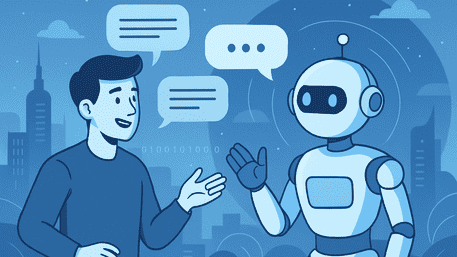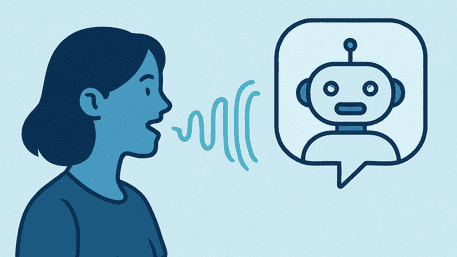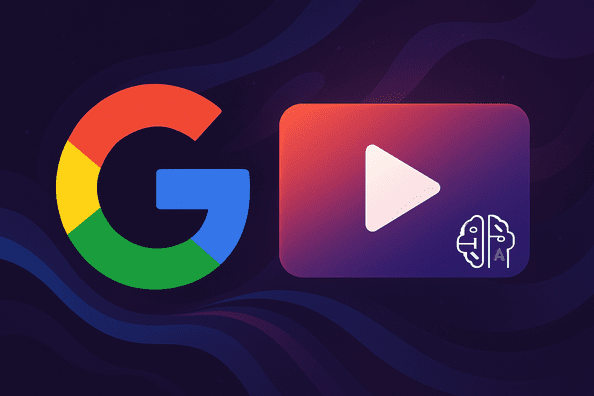Imagine chatting with a virtual assistant that not only understands your words but also picks up on your emotions, responds with warmth, and makes the entire conversation feel natural-almost like talking to a close friend. This is no longer a futuristic dream. Thanks to how ChatGPT’s new voice feature is transforming conversations, OpenAI has ushered in a new era of human-chatbot interaction. This voice mode is quietly revolutionizing the way we communicate with AI, making conversations more engaging, empathetic, and effective than ever before.
In this blog, we’ll dive deep into the impact of OpenAI voice mode on chatbot communication, explore real-world uses of ChatGPT voice conversations, compare ChatGPT Voice Mode versus traditional AI chat, and discuss ways businesses can use ChatGPT voice features to unlock new opportunities. Along the way, we’ll highlight the crucial role of emotional intelligence in ChatGPT voice interactions and why this technology is set to change the landscape of AI communication forever.
How ChatGPT’s New Voice Feature Is Transforming Conversations
The launch of ChatGPT’s voice mode marks a significant milestone in AI development. Traditional chatbot interactions have mostly relied on text, which, while functional, often lack the nuance and emotional depth of spoken communication. With the new voice feature, ChatGPT can now engage users in spoken dialogue, making conversations feel more natural and human-like.
Voice communication is inherently richer than text. When we speak, we convey not just words but tone, pitch, rhythm, and emotion. These vocal cues provide context that helps listeners understand meaning beyond the literal words. By integrating voice, ChatGPT can detect these subtle signals and respond accordingly, creating a more empathetic and personalized experience. This is a huge leap forward in AI communication, as it bridges the gap between human emotion and machine understanding.
Moreover, the voice feature enables multitasking and accessibility. Users can interact with ChatGPT hands-free, which is especially valuable for those who are driving, cooking, or have disabilities that make typing difficult. This accessibility factor alone is transforming how people use AI daily. The feature is also designed to sound natural and warm, avoiding the robotic, monotone voices that have historically characterized AI speech.
Real-World Uses of ChatGPT Voice Conversations
The practical applications of ChatGPT’s voice mode are already making waves across various sectors. From customer service to healthcare, education, and beyond, voice conversations with AI are enhancing user experience in meaningful ways.
In customer support, voice-enabled AI can handle complex queries with emotional sensitivity. For example, a frustrated customer calling a helpline can now receive calm, empathetic responses that help de-escalate tension. This not only improves customer satisfaction but also reduces the workload on human agents. Similarly, in healthcare, patients can describe symptoms verbally in their own words, and the AI can respond with reassurance or guidance, helping to alleviate anxiety before a clinical visit.
Education is another sector benefiting from this innovation. Voice tutoring powered by ChatGPT can adapt its tone and pace based on student responses, providing encouragement or slowing down explanations as needed. This personalized, conversational approach helps students stay engaged and better understand material. Additionally, for individuals with visual impairments or other disabilities, voice conversations open up new avenues for accessing information and services, making technology more inclusive.
Impact of OpenAI Voice Mode on Chatbot Communication
The impact of OpenAI voice mode on chatbot communication goes far beyond adding a new interface. It fundamentally changes the quality and depth of interactions between humans and machines.
Firstly, it enhances emotional intelligence in AI. Traditional chatbots often fail to recognize when a user is upset or confused, leading to frustrating experiences. With voice mode, ChatGPT can pick up on vocal cues such as hesitation, stress, or excitement and tailor its responses accordingly. This emotional awareness fosters trust and rapport, making users more likely to engage and return.
Secondly, voice mode reduces friction in communication. Typing can be slow or cumbersome, especially on mobile devices. Speaking is faster and more intuitive for most people, allowing conversations to flow naturally. This ease of interaction encourages users to ask more detailed questions and seek help in ways they might not have with text-only chatbots.
Finally, the voice feature supports richer multi-turn conversations. Because it can interpret tone and context better, ChatGPT can maintain the thread of a conversation more effectively, remembering prior points and responding in a coherent, context-aware manner. This leads to more satisfying and productive interactions.
ChatGPT Voice Mode Versus Traditional AI Chat
To appreciate the transformative power of ChatGPT’s voice mode, it’s helpful to compare it with traditional AI chat systems:
| Feature | Traditional AI Chat | ChatGPT Voice Mode |
| Interaction Medium | Text-based, typed input/output | Spoken dialogue with natural speech |
| Emotional Intelligence | Limited to text interpretation | Detects tone, pitch, and emotional cues |
| User Engagement | Often robotic or impersonal | Conversational, warm, and empathetic |
| Accessibility | Requires typing and reading | Supports hands-free, natural communication |
| Response Style | Instant text replies | Natural speech with pauses and intonation |
| Use Cases | FAQs, simple queries | Complex customer service, healthcare, education |
| User Experience | Functional but limited | Immersive and human-like |
Ways Businesses Can Use ChatGPT Voice Features
Businesses stand to gain immensely by adopting ChatGPT’s voice capabilities. Here are some ways businesses can use ChatGPT voice features to drive growth and improve customer relations:
- Customer Support Automation: Voice bots can handle routine inquiries and detect customer emotions, providing empathetic responses that reduce frustration and improve satisfaction.
- Sales and Lead Generation: Interactive voice assistants can engage prospects in personalized conversations, answer questions, and guide them through purchase decisions.
- Employee Assistance: Voice AI can help employees with scheduling, training, and quick access to company information, improving productivity.
- Market Research: Voice surveys capture not only answers but also sentiment and tone, providing richer insights into customer opinions.
- Brand Engagement: Creating a unique voice persona for your brand can make interactions memorable and foster stronger emotional connections.
By integrating voice mode, businesses can create seamless, human-like experiences that differentiate them in competitive markets.
Emotional Intelligence in ChatGPT Voice Interactions
One of the most remarkable features of ChatGPT’s voice mode is its emotional intelligence in ChatGPT voice interactions. Unlike earlier chatbots that responded mechanically, this voice mode can sense and respond to human emotions through vocal cues.
For example, if a user sounds anxious or upset, the AI can respond with a calming tone and reassuring language. If the user is excited or happy, the AI can match that enthusiasm, making the interaction feel more genuine. This emotional sensitivity helps build trust and rapport, which are critical for effective communication.
Moreover, the AI’s ability to use natural speech patterns-pauses, intonation, emphasis-makes conversations flow smoothly and feel less scripted. This subtlety is what makes ChatGPT voice mode stand out, turning AI from a cold machine into a conversational partner that users feel comfortable engaging with.
The Future of Human-Chatbot Conversations

Looking ahead, the integration of voice into AI chatbots like ChatGPT is just the beginning. As voice recognition and natural language understanding continue to improve, we can expect even more sophisticated interactions.
Future developments may include:
- Enhanced emotional detection that considers context and history.
- Multilingual voice conversations that break down language barriers.
- Integration with IoT devices for seamless smart home or workplace interactions.
- Personalized voice assistants that learn and adapt to individual user preferences and moods.
The impact of OpenAI voice mode on chatbot communication is already profound, and its ripple effects will shape how we interact with technology for years to come.
Conclusion: Embrace the Voice Revolution
In summary, how ChatGPT’s new voice feature is transforming conversations is nothing short of revolutionary. By adding natural speech, emotional intelligence, and accessibility, OpenAI’s voice mode is quietly changing human-chatbot conversations forever. It makes AI interactions more engaging, empathetic, and effective across industries and use cases.
Whether you’re a business leader looking to enhance customer experience or a tech enthusiast curious about the future of AI, embracing ChatGPT’s voice capabilities is a smart move. The technology is here, it works, and it’s ready to transform how we communicate.


